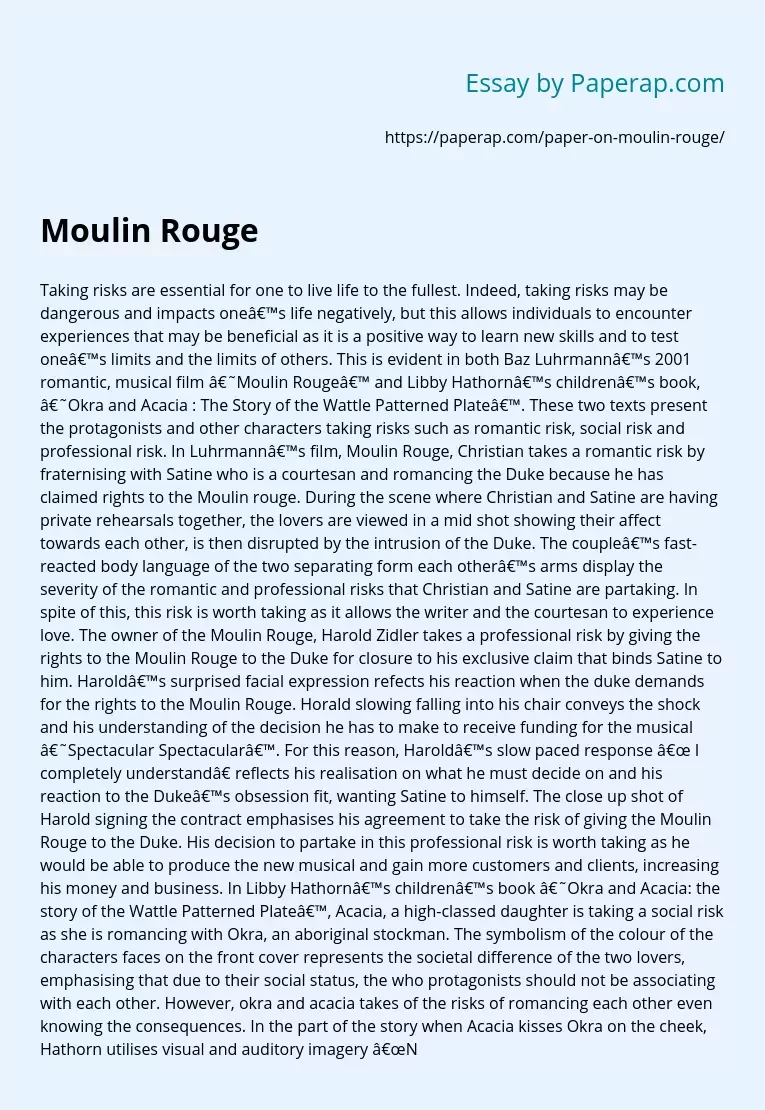Benefits of Taking Risks
Taking risks are essential for one to live life to the fullest. Indeed, taking risks may be dangerous and impacts one’s life negatively, but this allows individuals to encounter experiences that may be beneficial as it is a positive way to learn new skills and to test one’s limits and the limits of others. This is evident in both Baz Luhrmann’s 2001 romantic, musical film ‘Moulin Rouge’ and Libby Hathorn’s children’s book, ‘Okra and Acacia : The Story of the Wattle Patterned Plate’.
These two texts present the protagonists and other characters taking risks such as romantic risk, social risk and professional risk.
In Luhrmann’s film, Moulin Rouge, Christian takes a romantic risk by fraternising with Satine who is a courtesan and romancing the Duke because he has claimed rights to the Moulin rouge. During the scene where Christian and Satine are having private rehearsals together, the lovers are viewed in a mid shot showing their affect towards each other, is then disrupted by the intrusion of the Duke.
The couple’s fast-reacted body language of the two separating form each other’s arms display the severity of the romantic and professional risks that Christian and Satine are partaking. In spite of this, this risk is worth taking as it allows the writer and the courtesan to experience love.
The owner of the Moulin Rouge, Harold Zidler takes a professional risk by giving the rights to the Moulin Rouge to the Duke for closure to his exclusive claim that binds Satine to him.
Harold’s surprised facial expression refects his reaction when the duke demands for the rights to the Moulin Rouge. Horald slowing falling into his chair conveys the shock and his understanding of the decision he has to make to receive funding for the musical ‘Spectacular Spectacular’. For this reason, Harold’s slow paced response “ I completely understand” reflects his realisation on what he must decide on and his reaction to the Duke’s obsession fit, wanting Satine to himself. The close up shot of Harold signing the contract emphasises his agreement to take the risk of giving the Moulin Rouge to the Duke. His decision to partake in this professional risk is worth taking as he would be able to produce the new musical and gain more customers and clients, increasing his money and business.
In Libby Hathorn’s children’s book ‘Okra and Acacia: the story of the Wattle Patterned Plate’, Acacia, a high-classed daughter is taking a social risk as she is romancing with Okra, an aboriginal stockman. The symbolism of the colour of the characters faces on the front cover represents the societal difference of the two lovers, emphasising that due to their social status, the who protagonists should not be associating with each other. However, okra and acacia takes of the risks of romancing each other even knowing the consequences. In the part of the story when Acacia kisses Okra on the cheek, Hathorn utilises visual and auditory imagery “No lighting flashes and no thunder roared” displays the paradoxical effect of the two classes mixing with each other, therefore conveying that the protagonists should go forth and be together.
Furthermore, the two lovers also takes a romantic risk even knowing that their classes do not associate with each other, but also that Okra would be killed for ‘kidnapping’ acacia who in reality fled with okra to escape her engagement. Okra’s dialogue “they’ll kill me if they get me this time” displays the consequence of being together, placing stress and pressure on both lovers to be unnoticed and prevent being seen by her father and his men. The social and romantic risks that the lovers endured were worth taking as is proved that these people can be together and by taking these risks allowed them to live a happy life together.
Therefore it can be seen in Baz Luhrmann’s film ‘Moulin Rouge’, , and Libby Hathorn’s children’s book, ‘Okra and Acacia: The Story of the Wattle Patterned Plate’ , taking risks allows one to gain new experiences, skills and test one’s limits and the limits of other. Christian and Satine and Okra and Acacia were able to experience love and Harold’s business has increased due to his decision to give rights the Duke allowing him to fund the musical. Because these characters had decided to take these risks concerning their class, love and profession, they lived life to the fullest.
Benefits of Taking Risks. (2017, May 19). Retrieved from https://paperap.com/paper-on-moulin-rouge/

